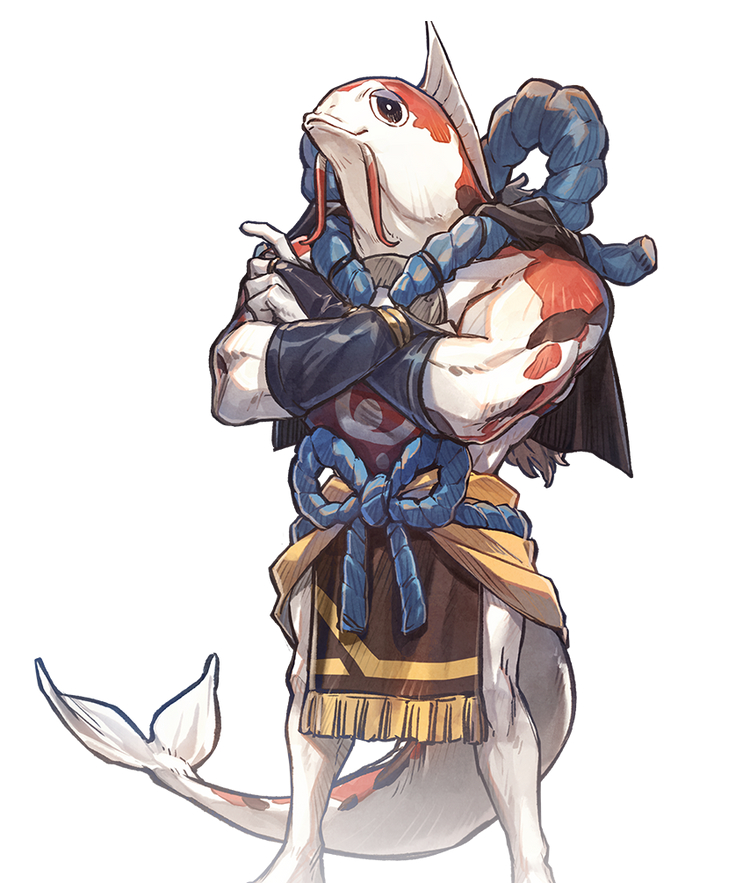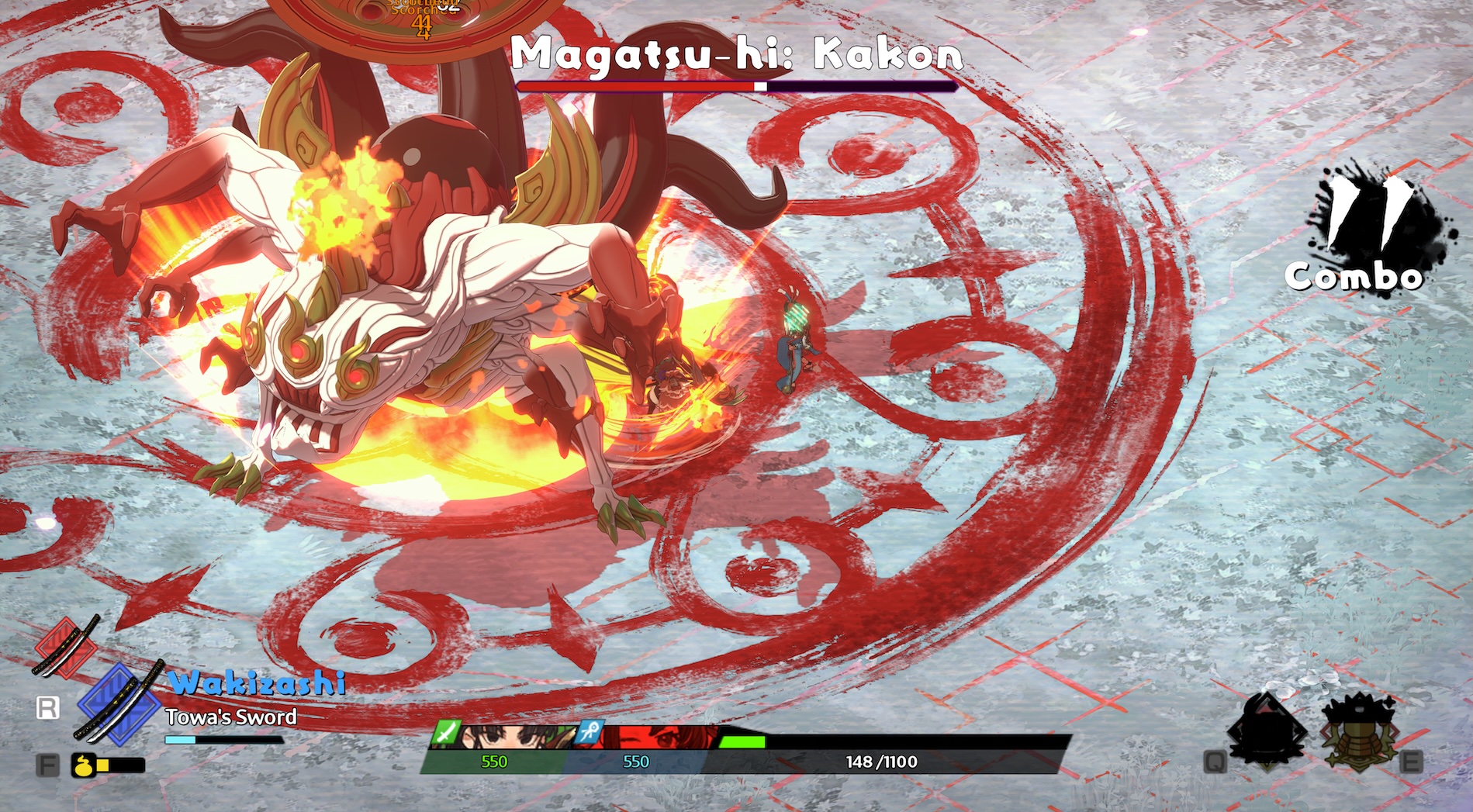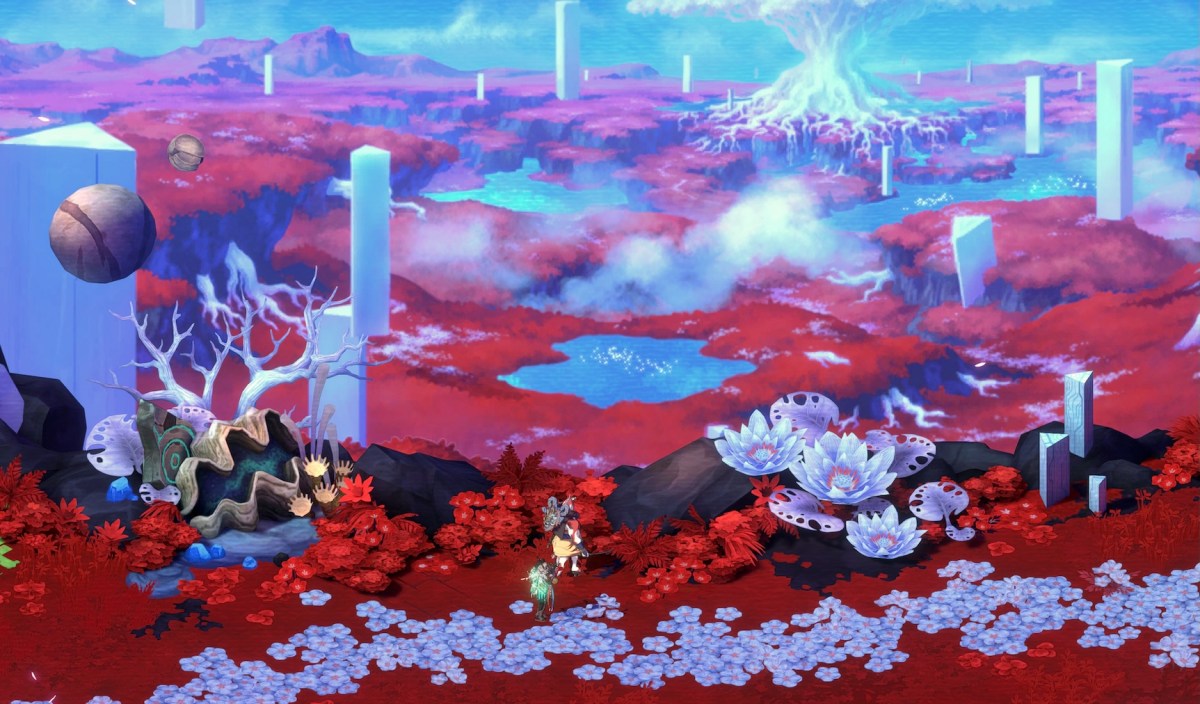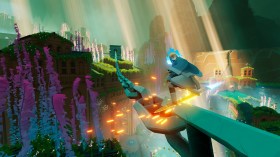Towa and the Guardians of the Sacred Tree is a beautiful experience. Every frame in this roguelite adventure has clearly been inspired by traditional Japanese artwork, with touches of bright colour and cel-shading making a pretty picture of your journey. Even when the plot of the game grows darker, there is always a brightness and levity, thanks to the lush strokes that bring this story to life.
After the first few hours of the game, I’ve become enchanted by the aesthetics on show, and particularly how the game depicts fluid, dramatic combat, and allows you to explore every corner of colourful, painterly worlds, with a sense of awe.
The premise here is surprisingly complex. You begin as Towa, the leader of a guardian group of warriors who protect Shinju Village from the encroachment of the evil Magatsu – a terrifying force who controls monsters and demons, many based on real-life tales of yōkai.

While most epic tales would begin with the slow march to victory, when Towa and the Guardians of the Sacred Tree opens, Towa has been defeated, with the threads of time and alternative universes unravelling quickly after. The guardians are scattered, and there appears to be little hope – but even facing the possibility of a definitive end, Towa strides forth to forge a new future, charting new universes to save all of Shinju Village. This is all explained in cutscenes designed to resemble living scrolls, distracting in their beauty.
From a central village hub, Towa is able to greet new versions of the guardians, and pick two to head into rounds of battle against each of Magatsu’s lieutenants. One hero becomes the ‘Tsurugi’ (embodying the power of the sacred sword) and another becomes the ‘Kagura’ (embodying the sacred staff) with each travelling in pairs to take down the spirits of evil.
Towa and the Guardians of the Sacred Tree: Long live Nishiki the fish warrior
With all the guardians to choose from, I quickly settled on Nishiki, an anthropomorphic koi who wears a solid suit of battle armour, and is able to swish across the battlefield in frantic, rolling arcs. My choice was mostly to do with his offensive capabilities, but he also rocks a very cool, very fun design. You wouldn’t think a koi’s face could be particularly expressive, but developer Brownies has done an excellent job infusing this character with personality.

That really goes for all the guardians, and the many folks you’ll meet in Shinju Village. Towa and the Guardians of the Sacred Tree is defined by a strong sense of style, and that extends to individual characters, many of which wear outfits that wouldn’t look out of place on the runway. With sweeping collars and complex kimono designs, each character stands out and carves a unique silhouette, so they become endearing almost immediately.
Given you’ll spend plenty of time with your chosen characters, dying again and again as you run through stages, battling beasts, you’ll want to feel that connection – and Towa and the Guardians of the Sacred Tree does a good job at establishing it immediately. You’ll know the stakes at a glance. You’ll know the danger. And you’ll want to protect Shinju Village from all harm.

What that requires of you is hard work and sacrifice, and a willingness to go around the bend, once, twice, and back again. How Towa and the Guardians of the Sacred Tree‘s roguelite elements work is this: you set off with your chosen Tsurugi and Kagura, and then you must conquer a beast hiding certain stages deep along a trail path.
In each area, you’ll face off with a horde of demons attempting to end your quest early, but if you stick it out, you can earn various rewards, including items for forging better weapons, and charms which may temporarily boost your character’s attack, defence, health, or other abilities.
Hades seems to be the modern milestone for the roguelite and roguelike genres, so I’ll say there’s some light similarities here, in that you’ll pick your paths based on possible power rewards, and keep forging ahead through winding and ever-more-dangerous paths, until you’re able to take down the boss. But there are more story and narrative elements here, with each boss being siloed into a separate roguelite chapter. You don’t need to play the whole game again if you die, you just need to take on your latest quest, and try again and again to conquer its gauntlet of challenges.
Even when dying resets progress, the loops remain engaging, thanks to Towa‘s mix of opportunities. If you’re playing on Story Mode, you get the benefit of being a bit more powerful with each failed run. Even if you’re not, you’ll find new ways to advance in the mix of Graces (power-ups) available, and which you choose to equip. Sometimes, you’ll randomly find a power-up that doubles your attack strength at the cost of half your health – so if you plan your fight well, you can dispatch enemies with ease. Sometimes, you can add extra firepower, or a blast of water, or some other elemental advantage. Every run is a new dawn, and brings you close to saving Shinju.
Towa and the Guardians of the Sacred Tree has impressed me in my first few runs, getting to grips with its fancy footwork, sharp swordplay, and varied elemental abilities. While I do think the story is somewhat more complex than it needs to be, the crux remains that it’s a bright, snappy experience with beauty in every facet, and writing that makes you care. It’s endearing all around, and certainly a game I’m going to be watching closely when it launches on 19 September 2025.
A preview copy of Towa and the Guardians of the Sacred Tree was provided and played on PC for the purposes of these impressions.





